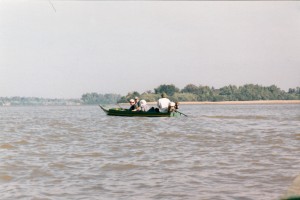[In January 2003 I accompanied an expedition that was conducting a survey of river dolphins on a stretch of the Mekong River in Cambodia. The expedition was led by Isabel Beasley, who was then a PhD student specializing on Orcaella brevirostris: also known as the ‘Irrawaddy Dolphin’ this species is found in many Asian river systems and deltas. The journal I kept during the expedition will appear on this site as a continuous series of posts. This is part 22 of the series.]
Yesterday I took three turns as Principal Observer. What it consists of is this: for the first half hour, the Observer is equipped with binoculars; either standing or sitting (on the camera case) he or she scans the water ahead, turning a regular 180 degrees from left to right; his/her magnified gaze sweeping the river, as it were, like the beam of a lighthouse. The second observer sits in front, watching the same field of vision with the naked eye; he too swivels his head as he sits, turning from one side to another at regular intervals. The idea is that even if something is missed by the observer with the binoculars, the naked-eye observer will pick it up. The binoculars have to be of a specification (70 x 50 ?) and they have to have a compass embedded in the eyepiece. Whenever an animal is sighted, the observer with the binoculars is required to take a compass reading of its location in relation to the direction in which the boat is headed.
The Principal Observer’s duties begin when the team goes On Effort. Every half hour the obsevers rotate: the PO with the binocs moves up to take the position of the naked eye observer; the naked eye observer moves aft where he/she can rest – and so on. At every change the observer with the binocs fills in a data sheet called the ‘Effort Sheet’. … The principle is that the entire river (or area under survey) will be subjected to the same intensity of gaze. This is the principle that governs the route taken by the surveying craft – there are protocols for making sure that the intensity of the gaze is exactly similar at every point…

